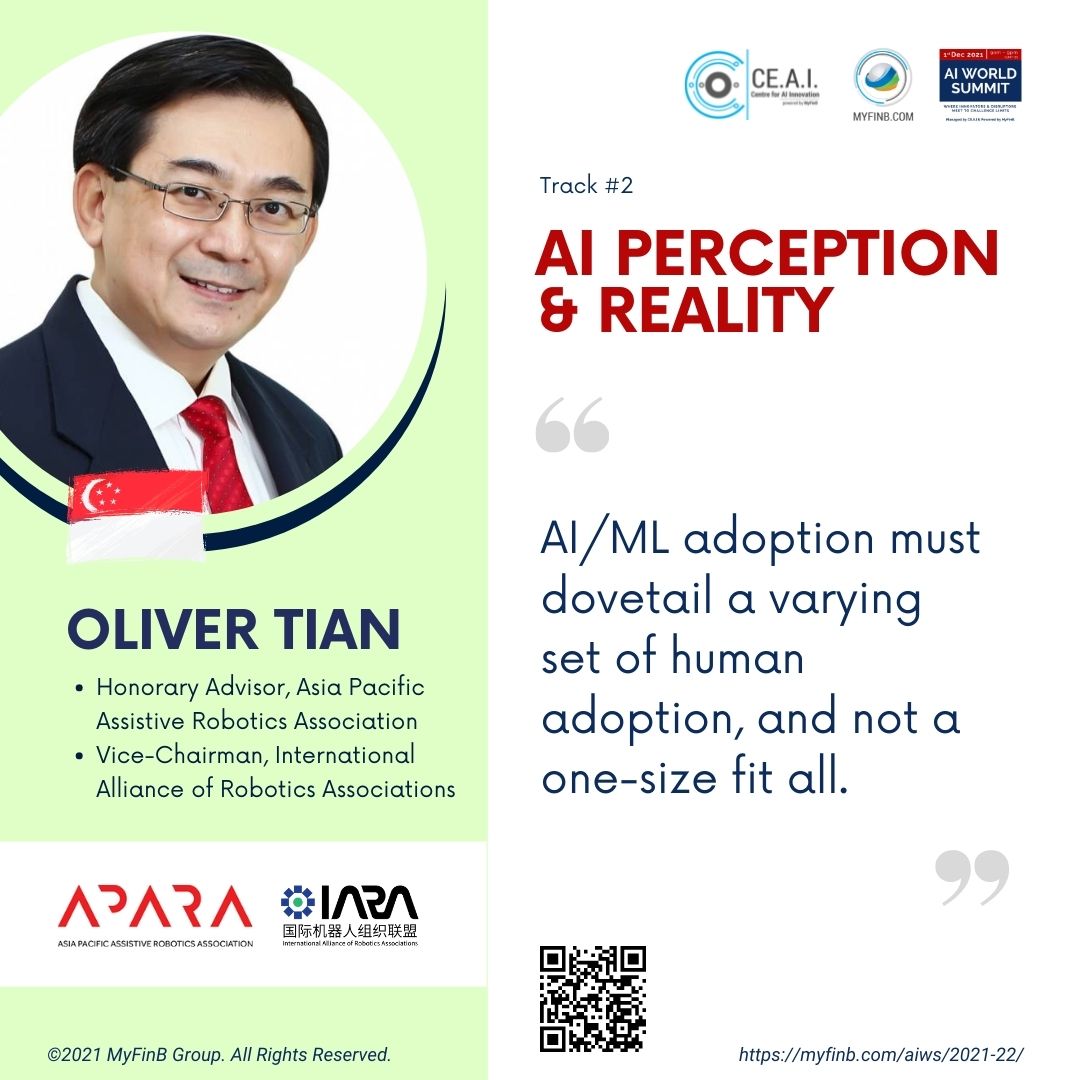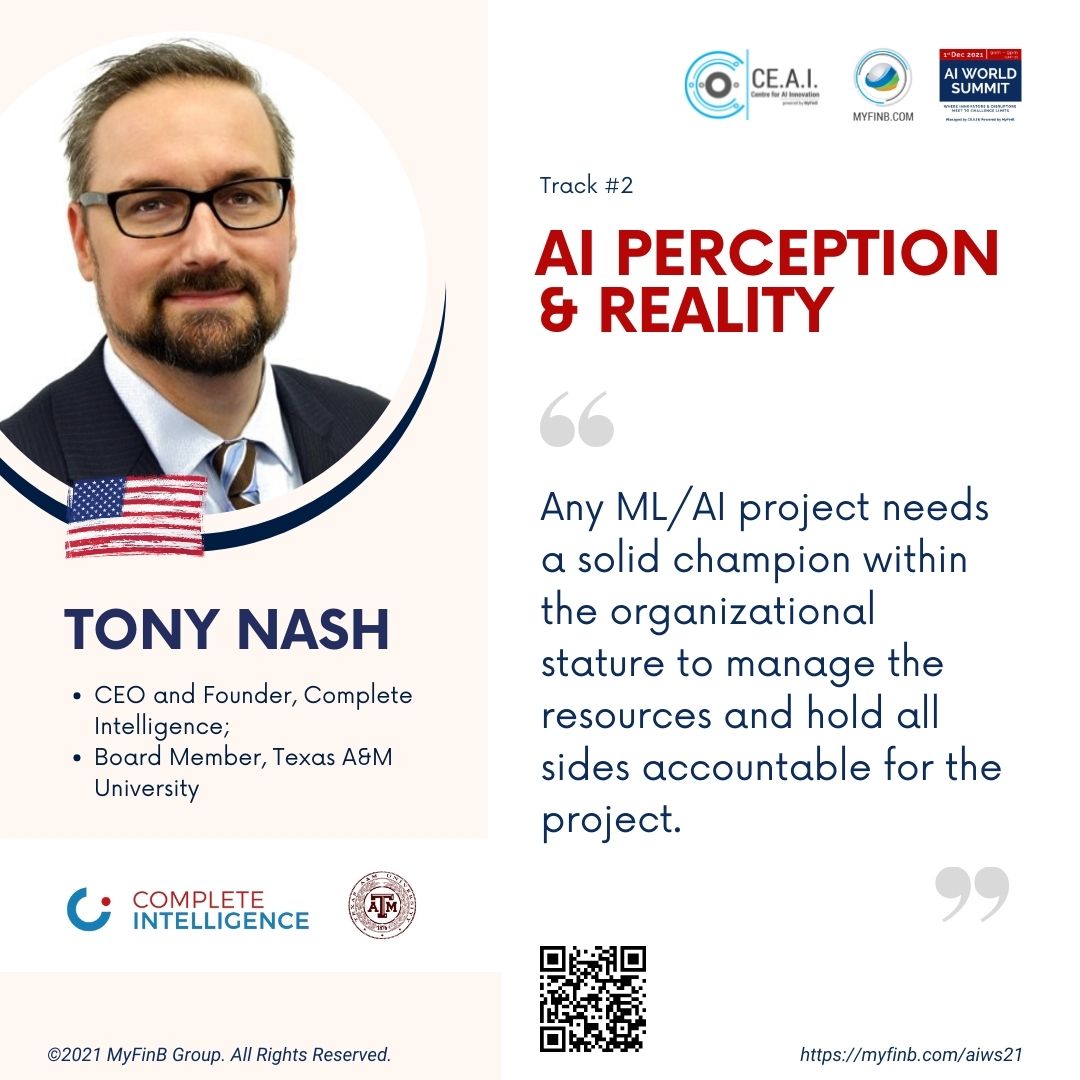AIWS'21 // Track #2
#2 - AI Perception & Reality

Key discussion points
- Where is the market in terms of real adoption of ML and AI?
- What are the data issues executives need to solve - or at least understand - before considering AI adoption?
- Challenges: What are the unstated assumptions that cause projects to get tripped up?
- "Plenty of AI projects end up as expensive science projects that businesses spend lavishly on, only to realize disappointment". Do you agree with this statement? Why or why not?
Given the hype surrounding artificial intelligence, businesses are now exceptionally eager to deploy this emerging technology.
SPEAKERS & SAYS
Stay tuned. More speakers are sharing their perspective soon.

1. Where is the market in terms of real adoption of ML and AI?
There are many practical areas … however, in the deployment of AI and ML, it is important to be realistic, and more importantly, to differentiate between Sci-fi movies and deployment in reality. There are three major factors to consider : Work processes, work competency, workplace configuration. In particular, there is huge potential in the human-machine collaboration area. AI must augment human capability, and ML must enhance human capability, all in all, adoption must dovetail a varying set of human adoption, and not a one-size fit all.
2. What are the data issues executives need to solve – or at least understand – before considering AI adoption?
Data is not everything. I hesitate to endorse that past data can solve all future problems. Data analytics can demonstrate past trends, but can be biased around how and what that data sets represent. There will always be hidden data which is not captured in digital form but reside in the human thoughts. Hence, the human validation on an on-going basis is critical.
3. Challenges: What are the unstated assumptions that cause projects to get tripped up?
AI projects must be considered globally and not scoped out narrowly to work in silos. Adopting AI to “plaster” a problem is probably set to fail.
4. Plenty of AI projects end up as expensive science projects that businesses spend lavishly on, only to realize disappointment”. Do you agree with this statement? Why or why not?
This is true! This is because, in designing an AI solution, there are many considerations. It involves a transformation of work process, competency and environment. Scope creeps appear because the AI adoption is not considered in full spectrum.
– Oliver Tian – Honorary Advisor, Asia Pacific Assistive Robotics Association; Vice-Chairman, International Alliance of Robotics Associations

1. Where is the market in terms of real adoption of ML and AI?
It’s very early, but there are a lot of opportunities. Obstacles are perceived high cost, lack of trust in the output and resource intensive deployment. That was true 5 years ago, but today, the cost, quality and resource intensity are much more aligned with the customer’s ultimate success.
2. What are the data issues executives need to solve – or at least understand – before considering AI adoption?
Machines need data to learn. Good data governance is important. If we don’t have consistent, well-managed data as a basis for learning, it usually takes more time to have a high-quality output. It’s not extraordinarily difficult to use data from multiple systems.
3. Challenges: What are the unstated assumptions that cause projects to get tripped up?
Any ML/AI project needs a solid champion within the organizational stature to manage the resources and hold all sides accountable for the project scope, tasks, deliverables, timelines, costs, etc. Also, creating and managing expectations of outcome.
4. Plenty of AI projects end up as expensive science projects that businesses spend lavishly on, only to realize disappointment”. Do you agree with this statement? Why or why not?
They can, but this is similar to implementing anything (e.g. new software system). It must be managed, there must be a consensus, a project manager, a plan, and “what defines success?”. It must have the appropriate attention and buy-in to be successful.
– Tony Nash – CEO and Founder, Complete Intelligence; Board Member, Texas A&M University
Interested to speak @ AIWS'21?
If you are interested in to become a speaker at AIWS 21/22, please kindly fill up the form below. Should you have any enquiries, please do not hesitate to get in touch with us.
Go to form: https://myfinb.com/aiws/2021-22/speaker-form
